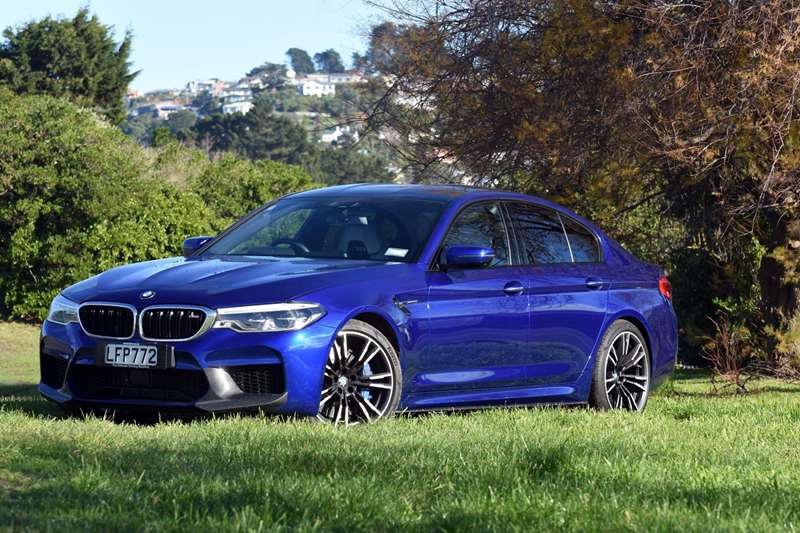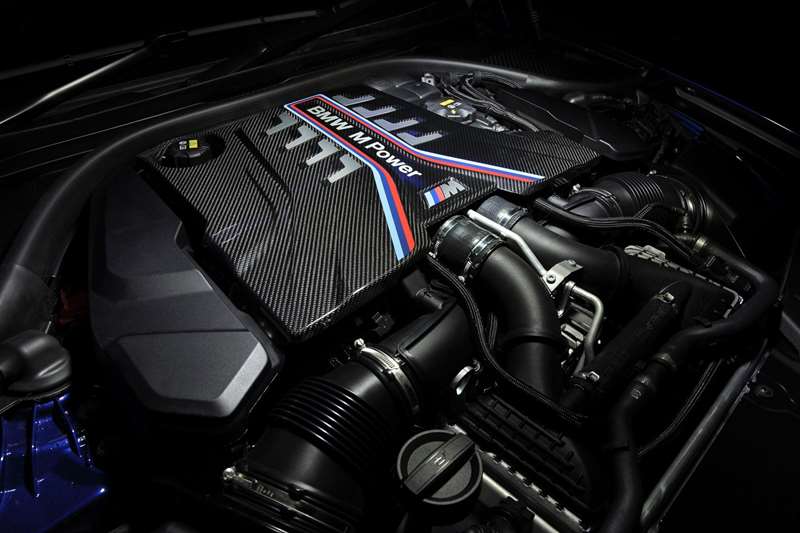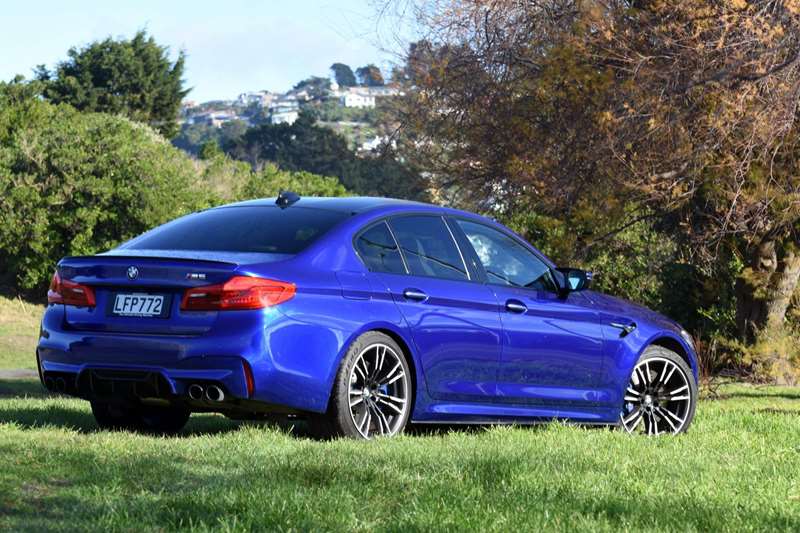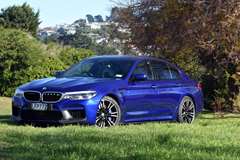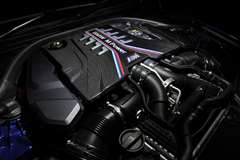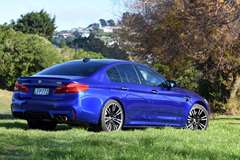| Price: | 206150 |
|---|---|
| Engine: | 4395cc twin turbocharged V8, maximum power 441kW@ 5600-6700rpm; maximum torque, 750Nm@ 1800-5600rpm |
| Transmission: | Eight-speed automatic, M xDrive all-wheel drive |
| Brakes and stability systems: | Disc brakes, ABS, BA, ASR |
| Safety: | Five-star European NCAP |
| Wheels and tyres: | Alloy wheels, 275/35 R20 front, 285/35 R20 rear tyres |
| Fuel and economy: | Premium unleaded petrol, 10.5 litres per 100km on European combined cycle, capacity 68 litres |
| Emissions: | 241g of CO2 per km |
| Dimensions: | Length 4965, width 1903, height 1473 |
Rating:
Overview
Switch off the traction control. Disable the new four-wheel-drive system so all power and torque is delivered to the rear wheels. Check the engine, gearbox and suspension are set in their most aggressive, sports-focused modes.
Accelerate steadily in a straight line. Then, at the appropriate point, up into second or third gear, flick the steering wheel to the left and stamp the throttle to the floor. As the tail steps out of line, steer into the developing power slide and work the accelerator to hold the car in that slide.
Marvel at how this, easily the most powerful of several BMW M-series available for today's drifting session, is also the easiest to hold in a controlled slide for half a minute, or maybe more.
That was my recent introduction to the latest BMW M5: taking a car that has, over five generations, earned legendary status as a luxury high-performance saloon par excellence, and sliding it through the snow at the Southern Hemisphere Proving Ground on the Pisa Range.
It was somewhat ironic that this introduction took place with the M5's four-wheel-drive system purposefully disabled, for this is the first M5 to feature an all-wheel-drive traction system.
So why has BMW abandoned a commitment to rear-wheel drive that has encompassed the M5 for close to four decades?
Credit two factors. Firstly, the 441kW of power and 750Nm of torque produced by the M5's twin-turbo V8 engine pushes beyond the boundary of what rear drive can sensibly handle. Secondly, all-wheel drive is now favoured for sport saloons in the crucial North American market.
Dubbed M xDrive, BMW's total traction system for the M5 utilises BMW's Active M differential and a highly sophisticated electronic brain that also works with the M5's adaptive sports suspension to maximise traction while keeping as much of a rear-drive feel as possible. As noted above, there's also the facility to run in pure rear-drive mode if desired.
The shift to all-wheel drive is accompanied by a major change in transmission. The old M5 featured a seven-speed dual-clutch automated manual transmission as standard, with a conventional manual six-speed available in some markets. This time round, a paddle shift-equipped eight-speed automatic is the sole gearbox on offer.
And while the 4.4-litre V8 carries over from the old M5, it is not quite the same engine: there are new turbochargers (nestled, as before, between the vee of the engine), a higher-pressure injection system and a new exhaust. As a result, power and torque are up 7% and 10% respectively.
Weight creep was a real risk with the introduction of all-wheel drive, but this has been mitigated by the use of lightweight panels, pressed in aluminium for the front wings and bonnet and shaped carbon fibre-reinforced plastic for the roof. The end result is a car that is actually 15kg lighter than the model it replaces. A further weight saving of 23kg can be had by ticking the carbon ceramic brake option, though this adds $15,000 to the M5's asking price.
Opt for the M5 in standard guise, and the tag is $199,900.
Key features provided by the standard specification include adaptive LED headlights, a premium Harman/Kardon sound system, leather trim, heated M-Sport front seats, quad-zone climate control, wireless smartphone charging, a head-up display and BMW gesture control. The safety specification includes adaptive radar cruise control, and lane-departure and lane-change warning systems. The M5 is also equipped with BMW's ConnectedDrive package and professional navigation system, accessed via a 10.25-inch centre touchscreen and iDrive rotary controller.
Having sampled the M5 at the snow farm, Drivesouth was provided with another for a conventional road test. Finished in a striking metallic blue, this car featured $6250 of optional equipment including cosmetic enhancements, front-seat ventilation and AppleCar Play integration (which really should be standard).
Styling-wise, this M5 shows its sporting side in a subtle way, via 20-inch alloys, a low-key body kit and discreet M-car badging.
Similarly, the cabin is classically elegant rather than ostentatious. The M5 is distinguished from other members of the current 5-series by red switchgear, illuminated M5 logos in the headrests of the sports seats and in the door sills, a sports steering wheel and aluminium carbon highlight panels.
While practicality is assured by a 530-litre boot and roomy rear seats, the focal point of the M5 cabin is the driver's seat. It, along with the steering wheel, provides ample adjustability and great ergonomics. Key controls fall neatly to hand, and the gentle angling of the dash towards the driver adds to the feel that the person behind the wheel occupies centre stage.
Customisation of a performance car's dynamic settings and instrumentation from the driver's seat is expected these days, and the new M5 certainly delivers. On the centre display one can, for example, call up real-time power and torque dials. Separate customisation of the stability control, four-wheel drive, engine, suspension and steering settings are also provided for.
The provision of Comfort, Sport and Sport+ settings is nothing new for BMW M-series owners, but as the first four-wheel-drive M-Car, the M5 breaks new ground with three additional drivetrain settings: 4WD, 4WD Sport and 2WD.
Potential confusion in selecting between these modes (or, indeed, a driver-selected combination of modes) is deftly avoided by two buttons able to be pre-programmed to give instant access to your favourite mode combinations. Finished in red, and labelled ``M1''and ``M2'', these are located on the spokes of the steering wheel.
After some experimentation, I selected 4WD Sport for its ``crackle and pop'' Sport + setting as the best performance mode on tarmac.
Although part of the engine's sound is contrived, via the audio system, there's no denying the uprated motor allows the M5 to run hard. The official 0-100kmh time of 3.4sec is within 0.1sec of the Mercedes-AMG E63 S tested on these pages a few weeks back, and a full second faster than that of the pervious M5 in standard guise.
Perhaps more importantly, the move to four-wheel drive has not resulted in an M5 shorn of driver-focused dynamic character.
Indeed, the cleverness of the M5's active differential is such that it feels more like a rear-wheel-drive than a four-wheel-drive car when pressed through tight twists and turns in 4WD Sport mode. Poise and balance turning into bends is outstanding, and even with the stability control system still partly enabled, there's an astonishing level of adjustability powering through and out of bends.
Criticisms, both nitpicking, are that the steering, while well weighted, lacks some feel, and the wide front tyres tend to tramline on poor tarmac surfaces; both likely consequences of the move to all-wheel drive. Overall, and just as it was in the snow, the new M5's agility on tarmac is remarkable for a car of this size.
Equally remarkable is its ability to completely switch character when in Comfort mode, and play the role of a pliant, cosseting, refined and smooth-riding luxury-focused executive saloon.
Cars that walk in the luxury and sporting worlds with the assurance of the new M5 are exceedingly rare, and that ability is what makes this car a particular treasure.
